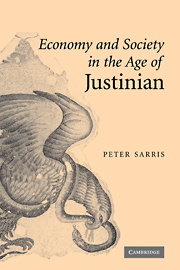Book contents
- Frontmatter
- Contents
- List of figures
- Preface
- Introduction
- 1 Egypt and the political economy of empire
- 2 The Apion archive: economic structure and estate accounts
- 3 Labour and administration: the evidence of the contractual papyri
- 4 Letters and petitions: social relations in the sixth-century Oxyrhynchite
- 5 The Apiones and their analogues
- 6 On the margins of magnate power: Dioscorus and Aphrodito
- 7 Landscapes of power: the great estate beyond Egypt
- 8 The historiography of the great estate
- 9 The great estate and the imperial authorities
- 10 The rise of the great estate
- 11 Economy and society in the age of Justinian
- Conclusion
- Bibliography
- Index
11 - Economy and society in the age of Justinian
Published online by Cambridge University Press: 24 July 2009
- Frontmatter
- Contents
- List of figures
- Preface
- Introduction
- 1 Egypt and the political economy of empire
- 2 The Apion archive: economic structure and estate accounts
- 3 Labour and administration: the evidence of the contractual papyri
- 4 Letters and petitions: social relations in the sixth-century Oxyrhynchite
- 5 The Apiones and their analogues
- 6 On the margins of magnate power: Dioscorus and Aphrodito
- 7 Landscapes of power: the great estate beyond Egypt
- 8 The historiography of the great estate
- 9 The great estate and the imperial authorities
- 10 The rise of the great estate
- 11 Economy and society in the age of Justinian
- Conclusion
- Bibliography
- Index
Summary
INTRODUCTION: THE AGE OF ANASTASIUS AND THE ARISTOCRATIC STATE
The late fifth century and, in particular, the reign of the Emperor Anastasius (r. 491–518) was clearly associated with a major consolidation of aristocratic power at the grassroots of early Byzantine society. Through the development of the offices of pagarch and vindex, magnate households tightened their control over the administrative and fiscal structures of provincial life. Accordingly, in the writings of John Lydus, Malalas, and Evagrius, the Anastasian era was remembered as having marked the effective end of curial self-rule. Instead, there had emerged from within and alongside the curiae what Liebeschuetz has described as ‘government by notables’. At the same time, Anastasius' monetary reforms and especially his introduction of a range of small denomination bronze coins proved popular with an aristocracy whose members' interests had long been bound up with the monetisation of the economy and the commutation of fiscal payments. As the Chronicle of Count Marcellinus declared: ‘By striking in his own name the copper coins which the Romans call “terunciani” and the Greeks “follares” the Emperor Anastasius brought a peaceful commutation to the people.’
Anastasius' policies clearly benefited the senatorial and land-owning elite. From their perspective, he behaved as all rulers should. John Lydus, for example, specifically singles out for praise Anastasius' generosity to members of the senatorial aristocracy.
- Type
- Chapter
- Information
- Economy and Society in the Age of Justinian , pp. 200 - 227Publisher: Cambridge University PressPrint publication year: 2006
- 1
- Cited by

